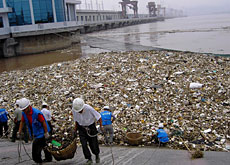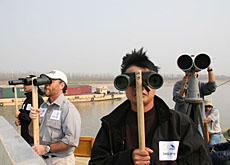Pollution levels “diluted” in Yangtze

Swiss and Chinese scientists have released the results of a water quality survey of the River Yangtze, declaring that the concentration of pollutants is not excessive.
The researchers, who monitored water quality along a 1,750km stretch of the river, said the Yangtze’s “enormous pollution levels” were diluted by the massive water flow.
Researchers from the Swiss Federal Institute of Aquatic Science and Technology and the Wuhan Institute of Hydrobiology examined the waters of the Yangtze during a six-week project last year.
Michael Berg from the Swiss institute, who took part in the expedition, told swissinfo the pollutant load from agriculture and industry was clearly increasing. Around 25 billion tons of waste is dumped into the Yangtze every year.
“Concentrations of pollutants in the Yangtze are comparable to the big European rivers, but taking into account the tremendous amount of water discharged by the Yangtze, the total load washed out into the estuary and the sea is considerable,” he said.
The Yangtze is the world’s third-largest river and water flow at the mouth of the river is ten times that of the Rhine. The sheer volume of water means it can hold great quantities of pollutants in relatively tolerable concentrations. Some 1,500 tons of nitrogen and 4.6 tons of arsenic are washed into the East China Sea each day.
One of the main sources of pollution in the river is agriculture, which uses an excessive amount of mineral fertilizers. Pressures on the Yangtze will continue to intensify with the growth in industry and a rising standard of living.
Lost dolphin
The same expedition that examined water quality also searched for the endangered Chinese river dolphin, or baiji, in order to move them to a reserve. But the expedition did not record any sightings of baiji.
Swiss conservationist and expedition organiser August Pfluger announced after the exhaustive search that the freshwater dolphin was “functionally extinct.”
However the water quality results show no direct correlation between the chemical water quality of the Yangtze and the disappearance of the baiji.
While water pollution was a damaging factor, other human activities such as increased waterway traffic and harmful fishing methods also proved treacherous for the dolphin.
Water quality is a hot topic in China with regular incidents of contamination affecting large numbers of people.
An algae bloom on Taihu Lake northwest of Shanghai in June prompted the suspension of running water in and around the major city of Wuxi for six days, forcing up to five million people to rely on bottled water.
Mother river
Professor Wang Ding of the Wuhan Institute of Hydrobiology was invited by the Swiss Agency for Development and Cooperation (SDC) to present the findings of the Yangtze research in the Swiss capital Bern.
“The support from the Swiss side is very important and it’s not only about money. It’s also about cooperation between different groups of people and organisations, which is very encouraging for us,” he told swissinfo.
Nearly 400 million people live in the Yangtze catchment area but the river is more than just a shipping channel, dumping ground and source of food and water for the people of the region.
Wang explained that the Yangtze is known as the mother river of China. “That says it all. It’s really important for the Chinese people… It is a part of your life, your motherland.”
The River Yangtze is 6,300km long.
400 million people live in the Yangtze Basin and consume its water.
It is the source of water for 40% of Chinese territory and 70% of the country’s rice fields.
Two-thirds of the fish eaten in China comes from the Yangtze.
25 billion tons of waste is released into the river each year.
The Yangtze is known as the “Golden Channel” because of its importance to trade and transport.
The water quality survey was part of the Yangtze Freshwater Dolphin Expedition, which took place in late 2006 under the banner of the baiji.org foundation.
Swiss and Chinese scientists collected hundreds of water and sediment samples along a 1,750km stretch of the river.
The expedition also searched without success for signs of the Chinese river dolphin, or baiji, ultimately concluding that the species was “functionally extinct”. The baiji survived for 20 million years.
Another rare mammal, the Yangtze finless porpoise, can still be saved if it is adequately protected from further adverse effects of pollution and human activity. Around 1,000 are thought to be still living in the wild, down from an estimated 2,700 in the early 1990s.
The expedition was carried out under the patronage of the Chinese Ministry of Agriculture, with the support of the Swiss Agency for Development and Cooperation, testing firm SGS and Pictet Bank.

In compliance with the JTI standards
More: SWI swissinfo.ch certified by the Journalism Trust Initiative



You can find an overview of ongoing debates with our journalists here. Please join us!
If you want to start a conversation about a topic raised in this article or want to report factual errors, email us at english@swissinfo.ch.